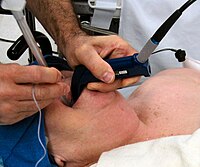
Photo from wikipedia
We read with great interest the article by Crewdson et al. [1], who investigated the demand for pre-hospital tracheal intubation in patients fulfilling the criteria for advanced airway intervention. After… Click to show full abstract
We read with great interest the article by Crewdson et al. [1], who investigated the demand for pre-hospital tracheal intubation in patients fulfilling the criteria for advanced airway intervention. After finding a higher mortality rate in the sub-group of patients who received emergency department tracheal intubation compared with pre-hospital non-tracheal intubation, they concluded there was an unmet demand for advanced airway management in the early phases of care. Nevertheless, several points have to be taken into account to validate their conclusion. Firstly, in order to make a reasonable comparison, the group of patients with pre-hospital airway intervention (n = 5968) should meet the criteria for advanced airway intervention (the presence of respiratory distress, haemodynamic instability, arterial oxygen desaturation) none of which were mentioned in the study. Secondly, based on an assumption that the sub-group of patients who received non-tracheal intubation interventions, such as pharyngeal tube or supraglottic airway device insertion (n = 1575) (Fig. 1 of [1]), all met the criteria for advanced airway intervention at their initial stages of care but received tracheal intubation at a later stage. The denominator for the calculation of mortality in this sub-group should therefore be 1575 rather than 881 (i.e. the number of patients receiving subsequent tracheal intubation after not including those not considered candidates for intubation, n = 694). This gives an actual mortality rate of 28.3% for this subgroup, a figure lower than that of the pre-hospital tracheal intubation sub-group (33.7%) (Table 2 of [1]). Using Chisquare test, the statistical difference is significant (Table 1) and therefore the conclusion of the study may need to be modified. Thirdly, considering the significantly lower mortality rate of the pre-hospital non-tracheal intubation intervention group compared with the pre-hospital tracheal intubation group, non-tracheal intubation interventions, such as pharyngeal tube or supraglottic airway device insertion may be considered effective steps for not including those who do not require subsequent tracheal intubation rather than being regarded as detrimental procedures. In the study by Crewdson et al. [1], those without subsequent tracheal intubation actually accounted for 44.1% of the population undergoing pre-hospital nontracheal intubation airway intervention (694/1575). We believe that these issues should be addressed before conclusions are reached related to this study.
Journal Title: Anaesthesia
Year Published: 2020
Link to full text (if available)
Share on Social Media: Sign Up to like & get
recommendations!